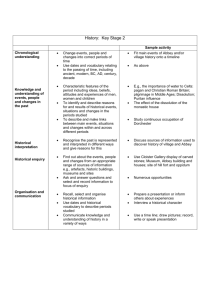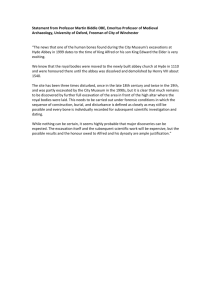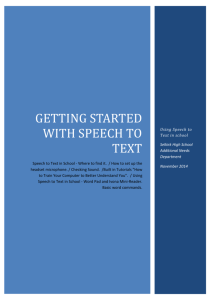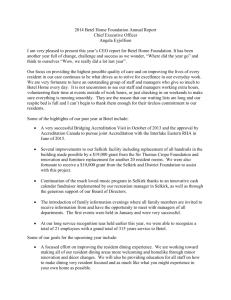Selkirk Churches and Abbey - Selkirk Castle Community
advertisement
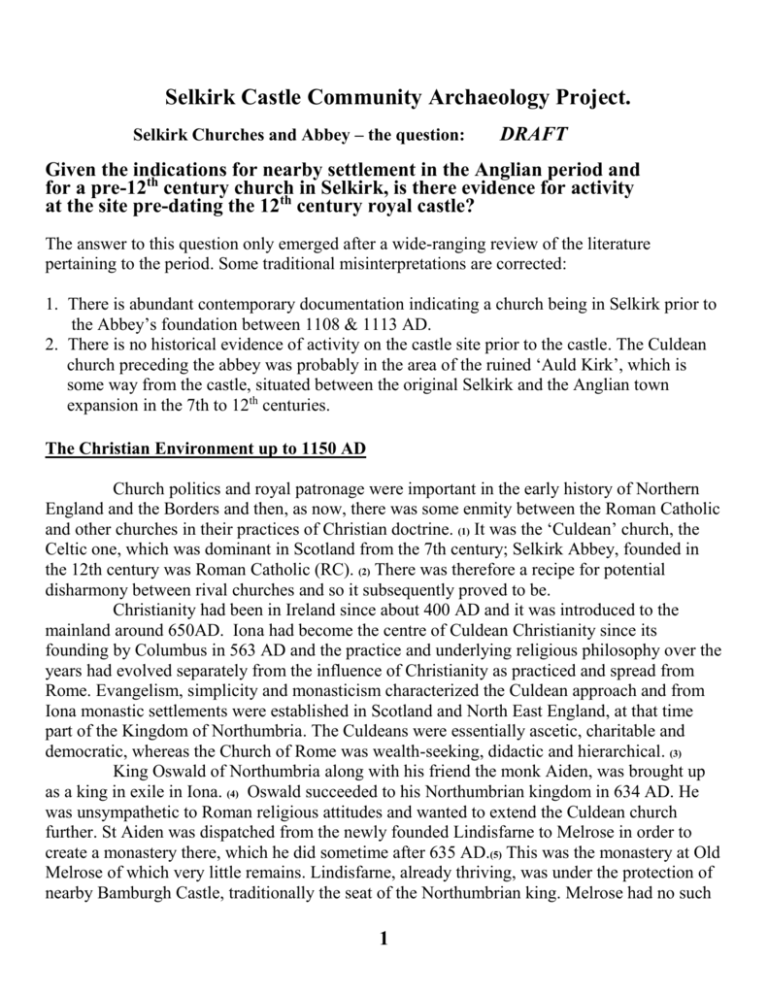
Selkirk Castle Community Archaeology Project. Selkirk Churches and Abbey – the question: DRAFT Given the indications for nearby settlement in the Anglian period and for a pre-12th century church in Selkirk, is there evidence for activity at the site pre-dating the 12th century royal castle? The answer to this question only emerged after a wide-ranging review of the literature pertaining to the period. Some traditional misinterpretations are corrected: 1. There is abundant contemporary documentation indicating a church being in Selkirk prior to the Abbey’s foundation between 1108 & 1113 AD. 2. There is no historical evidence of activity on the castle site prior to the castle. The Culdean church preceding the abbey was probably in the area of the ruined ‘Auld Kirk’, which is some way from the castle, situated between the original Selkirk and the Anglian town expansion in the 7th to 12th centuries. The Christian Environment up to 1150 AD Church politics and royal patronage were important in the early history of Northern England and the Borders and then, as now, there was some enmity between the Roman Catholic and other churches in their practices of Christian doctrine. (1) It was the ‘Culdean’ church, the Celtic one, which was dominant in Scotland from the 7th century; Selkirk Abbey, founded in the 12th century was Roman Catholic (RC). (2) There was therefore a recipe for potential disharmony between rival churches and so it subsequently proved to be. Christianity had been in Ireland since about 400 AD and it was introduced to the mainland around 650AD. Iona had become the centre of Culdean Christianity since its founding by Columbus in 563 AD and the practice and underlying religious philosophy over the years had evolved separately from the influence of Christianity as practiced and spread from Rome. Evangelism, simplicity and monasticism characterized the Culdean approach and from Iona monastic settlements were established in Scotland and North East England, at that time part of the Kingdom of Northumbria. The Culdeans were essentially ascetic, charitable and democratic, whereas the Church of Rome was wealth-seeking, didactic and hierarchical. (3) King Oswald of Northumbria along with his friend the monk Aiden, was brought up as a king in exile in Iona. (4) Oswald succeeded to his Northumbrian kingdom in 634 AD. He was unsympathetic to Roman religious attitudes and wanted to extend the Culdean church further. St Aiden was dispatched from the newly founded Lindisfarne to Melrose in order to create a monastery there, which he did sometime after 635 AD.(5) This was the monastery at Old Melrose of which very little remains. Lindisfarne, already thriving, was under the protection of nearby Bamburgh Castle, traditionally the seat of the Northumbrian king. Melrose had no such 1 stronghold protection but its site was readily defensible in its location, surrounded on three sides by the Tweed and on its fourth side by a defensible wall. Danes sacked Lindisfarne in 793 when Northumbria had ceased to be a kingdom, and it was no longer protected by Bamburgh Castle. Kenneth McAlpin burned Melrose Monastery in 749, presumably to assert his sovereignty. Both monasteries were subsequently rebuilt but Melrose appears to have still been in use at the time the first Roman Catholic religious establishments were founded by Earl David at the beginning of the 12th Century. (6) The first abbey he founded was in Selkirk. Earl David, who had become Earl of Northumbria in 1099, was brought up in England and influenced by RC religious practice. Up until that time the Culdean church had been the only one operating in the Borders. (7) Anxious to secure a significant religious profile and attract learned scholars to Scotland generally, to benefit the country educationally and culturally, Earl David went to Tyron, near Chartres, where an offshoot of the Benedictine monastery had been founded. His aim was to secure the help of the monks in founding his abbey in Selkirk, to meet the renowned St Bernard and also to gain divine approval. Accordingly, in 1109, (8) the monk Radulphus was sent to Selkirk along with 13 artisans by Benedictus, the first abbot of Tyron. It appears that Selkirk Abbey was built by 1113 and Radulphus was replaced by Benedictus in 1115. A Tyronensian monk, Gaufridus Grossus (9), relates that in “about 1108” Earl David had come to Tyron to meet St Bernard and returned to Selkirk Abbey “which he had already founded”. He never met St Bernard who had died before he got there. The actual date of foundation of Selkirk Abbey is therefore probably either 1108 or 1109 and its functional completion, 1113. Shortly after that, Earl David became King David I. It is important to recognise that these were very troubled times; Selkirk, owing to the Royal presence, was one of the most important towns in Scotland. It had been a centre of Scottish government where the king, from the safety of Selkirk Castle, both administered his kingdom and hunted in Ettrick Forest. Religious centres were, by their nature, vulnerable and largely unprotected; the sensible thing to do to protect against potential attack, therefore, was to site them near to an existing stronghold. Sir James Dalrymple, in his history of the Scottish Church, said in 1705 that King David founded abbeys “calculate to propagat the Romish religion in this kingdom upon the ruines and suppressions of the Culdean churches and monasteries”.(10) He also relates that John, the Catholic Bishop of Glasgow, had been driven out of the Borders owing to local opposition to Catholicism until ordered back by the Pope and again by King David in 1138. Sir James’ opinion was that the new abbey would have been molested “but for the protection afforded them by the prince’s castle of Selkirk, under the shadow of whose walls they commenced to rear their holy fane!”(11) It is accordingly logical to search for the remains of Selkirk Abbey near to the castle site and not so distant from the town as to be in an indefensible position if attacked – particularly by the opposing factions of the Culdean monks in Melrose and by antagonistic Selkirk people, adherents to the Culdean Church. 2 Historical references to Churches in Selkirk. The Culdean church had been evangelizing and practising in the Borders for nearly 500 years before the coming of the Roman church. It can therefore be assumed that any church in Selkirk established during that time was Culdean and was closely associated with the monastery in Melrose. The monastery’s main ‘raison d’être’ was to spread the ‘Christian Word’ and that must have included nearby Selkirk. It can likewise be assumed that the Christians attended a church in Selkirk which they had built themselves. On the evidence of the forced exile of the Bishop of Glasgow by locals, Culdean adherents obviously resented the intrusion of RC doctrine into the well-established religious practices they were used to.(13) So there must have been a long-established church in Selkirk pre-dating the Abbey foundation. This accords with the ‘kirk’ element in Selkirk’s name and King David’s reference to Selkirk being an “old town.” (14) One church or two? As outlined above, a Culdean church can be assumed to have existed in Selkirk prior to the Abbey’s founding and it is mentioned in contemporary accounts. Its date and site is unknown but might have been situated in the area of the present ruined ‘Auld Kirk’. (15) At the coming of the Abbey, an additional church of a different and opposing religious order to serve the Abbey would have been built as part of the Abbey founding by 1113. This second church/chapel appears not to have been removed to Kelso along with the Abbey in 1128. Selkirk therefore ended up having two churches with accounts of separate revenues proving their existence.(16) This second church was extant as late as 1534 in that a chaplain was nominated to it. It may however by then have simply been an honorary appointment. Two churches are referred to in three different contemporary sources; both charters of removal of 1147-52 & 1159, the diocesan records of the Bishop of Glasgow and a Papal ‘privilegium’.(16) Reference is also made to two Selkirks, Selkirk Abbatis (of the Abbot) and Selkirk Regis (of the King) with a church in each. Only archaeology can help locate either of these churches. Selkirk Abbey endowment lands Endowment by Earl David in his foundation charter to substantial land grants to the Abbey, (17) as far as landmarks relating to Selkirk are concerned, has sown confusion into the interpretation of the location of the Abbey which is further compounded later in the charter of removal. (18) The confusion arises from the description of the boundaries of the land granted. The identity of the ‘rivulet that falls into Yarrow’ has puzzled commentators leading to a supposition (19) that ‘Yarrow’ had been the name, in earlier times, of the Ettrick from the 3 ‘Meeting’ until it debouched into the Tweed. That gave credence to the assumption that the rivulet referred to was either the present Shawburn.(OS; Dean Burn) (20) or the ‘Batts Burn’ (21) and that the granted lands were to the east of Selkirk. Reference to the Blaeu map (22) and Pont’s drawings of 1590 shows that the best candidate for this western boundary is in fact the stream called the Howdenburn which at that time went into the Ettrick/Yarrow confluence at the Meeting of the Waters and could be said to debouch into either Yarrow or Ettrick as they are both there. Over time, this stream has changed course and now goes into the Ettrick. Thus there is no need to assume the Ettrick/Yarrow swapped their present names and the ‘rivulet that falls into Yarrow’ can be positively identified as the Howdenburn. On this understanding of its course change, the land grants in the Foundation Charter can now make sense. Abbey location The evidence for the Abbey’s location is sparse, but from the charters and for defensive purposes it would appear to have been close to the castle and as conjectured below could have been somewhere in the lower part of present-day Selkirk. Besides the substantial grants of land in Selkirk, bounded on the west by the ‘rivulet that falls into Yarrow’ terminating at the eastern end at the rivulet that ‘falls from Crossinmara into Tweed’ (Faldonside) there is an additional bit; “beyond the said rivulet that falls into Yarrow, a certain particle of land between the road which leads from the castle to the abbey and Yarrow, that is, towards the old town…”. (23) Furthermore, the charter of removal of 1147 is more specific in mentioning the piece of land beyond the rivulet and says “quondam particulam terrae inter viam quae venit de castello at super veterem abbathiam cadet in eodem rivulo, et Gieruam”. The Latin word ‘super’ in this context can equally mean ‘beyond’. The translation of this passage would then become; the ‘that particle of land between the road which comes from the castle and beyond the old abbey in the same way by the rivulet, and Yarrow.’ These clues point to the land being described here is the present Howdenhaugh, which lies south of the ‘Meeting of the Waters’ and lay just beyond the Howdenburn in c.1600. The road thus described also strongly hints that the Abbey was somewhere to the northeast of Selkirk ‘old town’. The ‘road from the castle’ could have been the old driveway into the Haining which meets the present Ettrick road opposite the supposed site of the old ‘village’ of ‘Larriston’. There are the traces of a road on Howden Hill heading towards Howden and Yarrow which could be the one referred to in the Foundation Charter. The unexcavated site of Larriston might have been part of Selkirk Abbatis’ which might have spread over the existing part of Selkirk in the Heatherlie/Kilncroft/Mill St. area. This latter part of town has, until the 1980s, been largely separate from the main part of Selkirk and connection to the rest if Selkirk only made during the 4 18/19th century. Kilncroft, as a name, may be a persistence of a corrupted ‘Kil’ element indicating a holy place. (16) Interestingly, the Glasgow diocesan rent rolls from the early 14th century record that Selkirk Abbatis consisted of 16 cottages, 3 breweries and a mill, together occupying at least 10 acres. The Abbot’s Selkirk was therefore quite sizeable.(24) Reference is made in Craig Brown (25) to the building at the foot of Tower St having been a tower, demolished in the early 18th century, and before that a substantial building which oral tradition has it, housed the 12th century artisans building the Abbey. This is credible but unconfirmed; the present charity shop replaced a jewellery business established in 1862 and excavation opportunities are unlikely. If true, the Abbey would have been nearby to facilitate access by the artisans involved in the building work. (26) The persuasive point underlying the supposition that the abbey was near the castle is the need for the abbey to have protection in the religiously hostile environment into which it was being introduced. The removal King David I moved his court and entourage from Selkirk to Roxburgh Castle sometime around 1120 and the Abbey having lost the guaranteed protection of the castle and the King’s presence in Selkirk, followed him to Kelso in 1126. During the brief time the Abbey was in Selkirk, the hostility of the Culdean church and local opposition had caused the bishop of Glasgow, in whose diocese Selkirk was, to absent himself to Tours for safety. We can only surmise that the monks at the Abbey were similarly threatened and took the first opportunity to safeguard themselves and the Abbey by moving away to Kelso and under the King’s protection at Roxburgh Castle. (27) Summary of Findings from a review of the available literature 1. 2. 3. 4. 5. 6. 7. 8. 9. There was a church in Selkirk prior to the abbey foundation. It was a ‘Celtic’ church, adherent to the Culdean doctrine. It was probably roughly where the present ‘Auld Kirk’ stands ruined. There is nothing to infer prior use of the castle site. Earl David’s grant to the Abbey of land in Selkirk extended from Howdenburn to Faldonside Burn. The foundation charter now makes sense. There was never a name change Yarrow/Ettrick. The Abbey, when founded, was probably in the Kilncroft area. The removal to Kelso was not weather determined, merely for protection. The Selkirk citizens appear to have preferred the Celtic Church to the Roman Catholic one and may partly have provoked the removal. 5 Bibliography & References: (1) Rev Adam Milne; Scottish Miscellanies; Melrose Parish. Pub. Alex McCaslan, Edinburgh 1769. (2) RCAHMS, Inventory of Roxburghshire 1955; I , 36. (3) Wikipedia ‘Culdees’ – (Web) (4) Catholic Encyclopaedia; St Oswald. - (Web) (5) Bede; Lib iv, Cap 27 (quoted in (1) “wherein (the monks at Old Melrose) they maintained themselves a long time against the canons and ordinances of the Romish councils so much pressed upon them by the disciples and proselytes of that See.” (6) Dalrymples Collections p7 (quoted in (1) (7) J Gilbert (ed); Flowers of the Forest, 1985, pp 21-23. Selkirk CR Trust. (8) Chronica de Mailros, Bannatyne Club, Edinburgh 1835; p 65 (9) Gaufridus Grossus; quoted in Craig brown, T.; History of Selkirkshire, 1886 II p4 Sir James Dalrymple of Borthwick Bt, Collections Concerning the Scottish History 1705 (quoted in (12) p 4. NLS Adv.ms.49.7.12 (11) ‘fane’ = desire, loving purpose. (10) (12) Craig brown, T; History of Selkirkshire. ; David Douglas, Edinburgh, 1886; II p 4 (Hereafter ‘CB’) (13) CB – Appendix. Charter of Foundation.1119 (14) ibid (15) J Gilbert (ed); Flowers of the Forest, 1985; map facing p 27 (16) CB p 6. (17) CB – Appendix. Charter of Foundation. 1119 (18) CB – Appendix .Charter of Removal. 1147 (19) CB - II p5 (20) ibid (21) J Gilbert (ed); Flowers of the Forest, 1985; p21. (22) J Blaeu, maps of ‘Teviota’ & ‘Twee-Dail’ 1654 (after T Pont 1580-90)) (Incidentally, Selkirk is shown on both maps as a town surrounded by encircling fortifications) (23) CB – Appendix. Charter of Foundation. 1119 (24) CB p 6. (25) CB p. 7 (26) (27) . ‘The Souters o’ Selkirk’ A panorama of Eight Centuries ;Published in Selkirk by G Lewis & Co 1910-1914 CB p.7 © LDN 17/9/13 6 7


